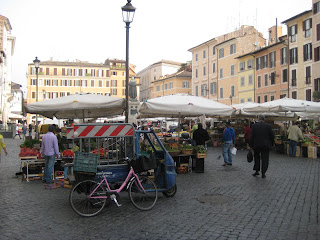 When you have some free time in the afternoon, you should take a walk over to the Campo de'Fiori. You will be treated to see a transformation in the Piazza itself. Food vendors from the morning markets begin to break down their stands. Now more tourists are out and the shop vendors know this. Jackets that are ten euros early in the morning are now twelve. But don't worry, if you have luck like my friend and I did, they will have a special discount just for you.
When you have some free time in the afternoon, you should take a walk over to the Campo de'Fiori. You will be treated to see a transformation in the Piazza itself. Food vendors from the morning markets begin to break down their stands. Now more tourists are out and the shop vendors know this. Jackets that are ten euros early in the morning are now twelve. But don't worry, if you have luck like my friend and I did, they will have a special discount just for you. Morning trash piles up while right next to it vendors lay out Prada and Gucci bags that are of course originals. The umbrellas are up in bars that had only served coffee in the mornings. And the scents of the day are out in full force. Walk down the road a little and smell the fresh fish market. There is a good chance you can already start to smell it from the Piazza. On the other hand, walk to the opposite corner of the market and smell the delicious goods Forno's is making today.
 No matter what you choose to see in the afternoon, make sure you take the time to sit down and have gelato from one of the many small shops. While this is no Giolitti's, I find I can't refuse a scoop or two myself.
No matter what you choose to see in the afternoon, make sure you take the time to sit down and have gelato from one of the many small shops. While this is no Giolitti's, I find I can't refuse a scoop or two myself. If you have more time, venture down some of the side streets. You will find nice designer clothes right next to discount stores. If you are looking for a relaxing afternoon, this is the place to come.





















